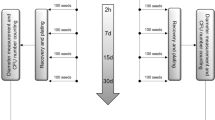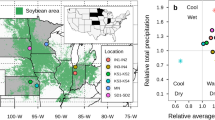Abstract
The objective of this study was to quantify changes in soybean seed quality characteristics in response to indigenous Bradyrhizobium inoculation and N fertilization applied under field conditions during the years 2009 and 2010. Seven indigenous Bradyrhizobium isolates were isolated from the different locations under the foothills of great Himalayas Rawalakot Kashmir, Pakistan. The field isolates were compared to a reference strain (exotic) TAL102, three N fertilizer rates and to an un-inoculated control. The seed oil content, fatty acid composition, seed N, P and K concentration and seed N, P and K uptake were quantified. Bradyrhizobium inoculation and N fertilization significantly increased oil content compared to the un-inoculated control. The seed oil content varied between 16.2 and 21.5 %, highest in the seeds treated with indigenous Bradyrhizobium strains NR22, NR25 and NR35, and mainly composed of linoleic acid (47 %), and oleic acid (24 %). Inoculation and N fertilization both decreased the saturated fatty acids (palmitic and stearic) and increased unsaturated fatty acids (linoleic acid and oleic acid). The mineral nutrient content of N, P, and K and their accumulation in seed increased by 2–3-fold compared to the corresponding control. Indigenous Bradyrhizobium strains were able to generate the highest values for seed oil content (NR22, NR25, and NR35), unsaturated fatty acids, i.e. linoleic acid and oleic acid (NR25, and NR35) and N, P and K uptake (NR20, and NR22). There were noticeable differences among the treatments in terms of essential fatty acid, oil, and mineral nutrient content. The study demonstrates the potential benefits of using indigenous Bradyrhizobium strains in order to achieve high quality soybean seeds that can be used as a balanced health product.
Similar content being viewed by others
References
Dwevedi A, Kayastha AM (2011) Soybean: a multifaceted legume with enormous economic capabilities. In: Ng TB (ed) Soybean—biochemistry, chemistry and physiology. InTech Publisher, Janeza Trdine, Croatia, pp 165–188
Hymowitz T, Singh RJ, Kollinpara KP (1998) The genomes of the glycine. Plant Breed Rev 16:289–311
Abbasi MK, Tahir MM, Azam W, Abbas Z, Rahim N (2012) Soybean yield and chemical composition in response to phosphorus–potassium nutrition in Kashmir. Agron J 104:1476–1484
Raei E, Sedghi M, Sharifi SR (2008) Effect of Bradyrhizobium inoculation, application of nitrogen and weeding on growth and seed filling rate in soybean. J Agric Technol 12:81–91
Graham PH, Vance CP (2003) Legumes: importance and constraints to greater use. Plant Physiol 131:872–877
Hafeez FY, Hameed S, Ahmad T, Malik KA (2001) Competition between effective and less effective strains of Bradyrhizobium spp. for nodulation on Vigna radiata. Biol Fertil Soils 33:382–386
Da HN, Deng SP (2003) Survival and persistence of genetically modified Sinorhizobium meliloti in soil. Appl Soil Ecol 22:1–14
Naeem FI, Ashraf MM, Malik KA, Hafeez FY (2004) Competitiveness of introduced Rhizobium strains for nodulation in fodder legumes. Pak J Bot 36:159–166
Rai R, Dash PK, Mohapatra T, Singh A (2012) Phenotypic and molecular characterization of indigenous rhizobia nodulating chickpea in India. Indian J Exp Biol 50:340–350
Rennie RJ, Dubetz S, Bole JB, Muendel HH (1982) Dinitrogen fixation measured by 15N isotope dilution in two Canadian soybean cultivars. Agron J 74:729–730
Hatam M, Abbasi GQ (1994) Oil seed crops. In: Nazir S, Bashir E, Bantel R (eds) Crop production. National Book Foundation, Islamabad, pp 329–335
Nangju D (1980) Soybean response to indigenous rhizobia as influenced by cultivar origin. Agron J 72:403–406
Bellaloui N, Bruns HA, Gillen AM, Abbas HK, Zablotowicz RM, Mengistu A, Paris RL (2010) Soybean seed protein, oil, fatty acids, and mineral composition as influenced by soybean-corn rotation. Agric Sci 1:102–109
Patra RK, Pant LM, Pradhan K (2012) Response of soybean to inoculation with rhizobial strains: effect on growth, yield, N uptake and soil N status. World J Agric Sci 8:51–54
Solomon T, Pant LM, Angaw T (2012) Effects of inoculation by Bradyrhizobium japonicum strains on nodulation, nitrogen fixation, and yield of soybean (Glycine max L. Merill) varieties on Nitisols of Bako, Western Ethiopia. ISRN Agron. 2012, D 261475, doi:10.5402/2012/261475
Bremner JM, Mulvaney CS (1982) Nitrogen—total. In: Page AL, Miller RH, Keeney DR (eds) Methods of soil analysis, Part 2: chemical and microbiological properties. SSSA, Madison, pp 595–624
Murphy J, Riley JP (1962) A modified single solution method for the determination of phosphate in natural waters. Anal Chim Acta 27:31–36
Winkleman GE, Amin R, Rice WA, Tahir MB (1990) Methods manual soil laboratory. BARD Project, PARC
Abbasi MK, Tahir MM, Azam W, Abbas Z, Rahim N (2012) Soybean yield and chemical composition in response to phosphorus–potassium nutrition in Kashmir. Agron J 104:1476–1484
Pazdernik DL, Killam AS, Orf JH (1997) Analysis of amino and fatty acid composition in soybean seed, using near infrared reflectance spectroscopy. Agron J 89:679–685
NF V 03-908 (2009) Oilseeds: determination of oil content (alternative method). AFNOR
Hartwig RA, Hurburgh CR (1991) Inter laboratory comparison of soybean protein and oil determinations. J Am Oil Chem Soc 68:949–955
MSTAT-C (1991) A software program for the design, management, and analysis of agronomic research experiments. Michigan State University, East Lansing
Muhammad F (1995) Correlations. Statistical methods and data analysis, 1st edn. Kitab Markaz, Faisalabad, pp 252–268
Tahir MM, Abbasi MK, Rahim N, Khaliq A, Kazmi MH (2009) Effect of Rhizobium inoculation and NP fertilization on growth, yield and nodulation of soybean (Glycine max L.) in the sub-humid hilly region of Rawalakot Azad Jammu and Kashmir Pakistan. Afr J Biotechnol 8:6191–6200
Akbari P, Ghalavand A, Sanavy AM, Alikhani MA (2011) The effect of biofertilizers, nitrogen fertilizer and farmyard manure on grain yield and seed quality of sunflower (Helianthus annuus L.). J Agric Technol 7:173–184
Kumar V (1994) Nitrogen economy in Indian mustard through use of Azotobacter chroococcum. Crop Res 8:449–452
Shahid MQ, Saleem MF, Khan HZ, Anjum SA (2009) Performance of soybean (Glycine max L.) under different phosphorus levels and inoculation. Pak J Agri Sci 46:237–241
Furseth BJ, Conley SP, Ane JM (2012) Soybean response to soil rhizobia and seed-applied rhizobia inoculants in Wisconsin. Crop Sci 52:339–344
Ahmed FE (2013) Interactive effect of nitrogen fertilization and Rhizobium inoculation on nodulation and yield of soybean (Glycine max L. Merrill). Glob J Biol Agric Health Sci 2:169–173
Kang BT (1975) Effects of inoculation and nitrogen fertilizer on soybean in western Nigeria. Exp Agric 11:23–31
Nasim W, Ahmad A, Hammad HM, Chaudhary HJ, Munis NFH (2012) Effect of nitrogen on growth and yield of sunflower under semi-arid conditions of Pakistan. Pak J Bot 44:639–648
Achakzai AKK, Kayani SA, Yaqoob M, Nabi A (2003) Chemical composition of soybean cv. Williams-82 seeds in pot culture experiments. J Biol Sci 3:882–891
Bybordi A (2011) Effect of ammonium : nitrate ratio on fatty acid composition and proline accumulation of canola cultivars grown under salinity stress. Afr J Biotechnol 10:16826–16832
Anderson JW, Beardall J (1999) Molecular activities of plant chemistry. Blackwell, Oxford
Kheir NF, Harb EZ, Moursi HA, El-Gayar SH (1991) Effect of salinity and fertilization on flax plants (Linum usitatissimum L.) II. Chemical composition. Bull Fac Agric (Univ Cairo) 42:57–70
Carroll KK (1986) Biological effects of fish oils in relation to chronic diseases. Lipids 21:731–732
Krueger K, Goggi AS, Mallarino AP, Mullen RE (2013) Phosphorus and potassium fertilization effects on soybean seed quality and composition. Crop Sci 53:602–610
Duraisami VP, Mani AK (2001) Residual effect of inorganic nitrogen, composted coir-pith and biofertilizer on yield and uptake of soybean in an Inceptisol. Madras Agric J 88:277–280
Kumawat SM, Dhakar LL, Maliwal PL (2000) Effect of irrigation regimes and nitrogen on yield, oil content and nutrient uptake of soybean (Glycine max). Indian J Agron 45:361–366
Okereke GU, Onochie C, Onukwo AU, Onyeagba E, Ekejindu GO (2000) Response of introduced Bradyrhizobium strains infecting a promiscuous soybean cultivar. World J Microbiol Biotechnol 16:43–48
Acknowledgments
This work was supported and funded by the Higher Education Commission (HEC), Islamabad Pakistan via research project No. 20-1621 R&D/HEC/2013 under the National Research Program for Universities (NRPU).
Author information
Authors and Affiliations
Corresponding author
About this article
Cite this article
Rahim, N., Kaleem Abbasi, M. & Hameed, S. Soybean Seed Quality Characteristics in Response to Indigenous Bradyrhizobium Inoculation and N Fertilization in Kashmir–Pakistan. J Am Oil Chem Soc 92, 1165–1174 (2015). https://doi.org/10.1007/s11746-015-2682-8
Received:
Revised:
Accepted:
Published:
Issue Date:
DOI: https://doi.org/10.1007/s11746-015-2682-8




